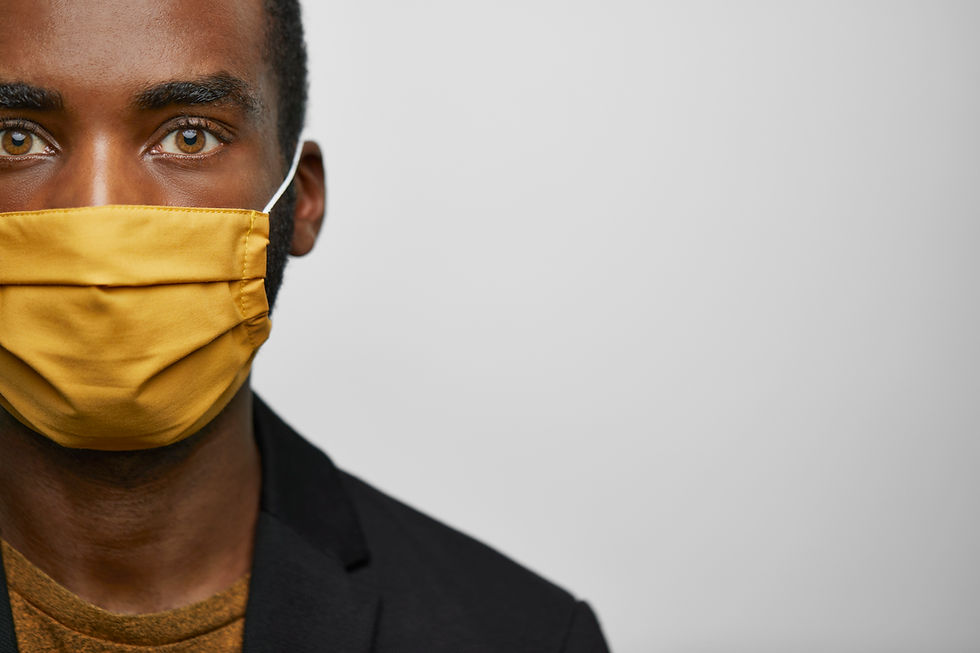#FaceFacts
- Pauline Hoffmann
- Apr 29, 2021
- 4 min read
Updated: Nov 4, 2021

This article was written by Xiaoning Zhang, Professor of Biology and Director of the Biochemistry Program, Pauline Hoffmann, Associate Professor and former dean of the Jandoli School of Communication, and Mary Rose Kubal Associate Professor of Political Science and Acting Director of the International Studies Program. (For more information about Covid, please listen to Part 1 and Part 2 of my podcast conversation with Xiaoning Zhang.)
#EasyOnTheSneezy. While there are still many unknowns related to SARS-CoV-2 (the coronavirus which causes the disease COVID-19), it is known that the eyes, nose and mouth are three main entries for the infection. While we are asked to stay at home and limit social contact, essential activities are unavoidable - grocery store runs, pharmacy and doctor visits. When visiting these places, we are potentially exposed to contagions because it is not always possible to maintain the “6-foot zone” of social distancing in a confined public space.
In addition to hand washing and social distancing, another way to protect oneself is to wear a face mask when out in public. (Instructions for mask removal appear later in this editorial.) Due to the alarming shortage of medical masks, facilities like Roswell Park Cancer Institute have started to accept donations of washable face masks for non-emergency use. A recent article in this paper noted how the community has come together to make face masks for those most in need like health care workers, the elderly, and others who have compromised immune systems. We would like to encourage everyone in the community to wear a face mask – and make it a perfectly normal act of self care and courtesy to others - when it is necessary to be in shared public spaces.
Remember that COVID-19 may not cause severe symptoms for most people. However, ones with mild to no symptoms can still be contagious and spread the virus to those who may not be able to combat its effects.
One important question we have gotten is, “are handmade face masks effective?”
Currently, the most effective type of mask to prevent most viral particles from getting in one’s nose and mouth is N95. But the reality is that there are not enough of those masks to go around. Unless you are in a place in which the viral density is high like an ICU, a handmade face mask is better than no cover at all. Deaconess Health System has suggested a CDC-compliant handmade face mask that has at least two layers of 100% cotton fabric and three folds when the medical-grade masks are not available.
This double-layer mask can catch large droplets from other people, such as saliva from talking, laughing, or coughing and nose discharge from sneezing. The fluid droplets can be vehicles for germs including the SARS-CoV-2 virus. Viruses don’t have legs or wings. They may be able to float in the air for about three hours and don’t travel very far on their own (hence the reason for the 6-foot social distancing precaution). If someone were to sneeze or cough, large droplets containing the virus could land and attach on the outside layer of a mask. The key is to keep the mask dry to reduce the chance for the attached virus to move through layers and reach the nose and mouth quickly. When masks are wet, this could occur. It takes time for tiny viral particles to go through your wet face mask, it will happen, but it is not immediate. One should replace a wet or damp mask with a dry one as soon as possible.
In order to ensure the cotton face mask continues to be effective, you should take it off when you are no longer in public. Masks should be replaced after four hours of wear. After using it, one can (STEP 1) remove the mask by only holding the ear loops or strips on both sides, (STEP 2) fold the outside surface inward, and (STEP 3) place it in a clean sandwich bag. When home, place the safely stored used mask directly in a pot of boiling water for 30 minutes and wash your hands with soap and water. Research has shown that this kills the virus and makes the cotton mask reusable once dried (either air dry or in a dryer). This three-step process can prevent one from transferring contaminants from the surface of the mask, to other surfaces and eyes, nose or mouth. It takes some practice, but it is simple enough to do. If you are using disposable masks, you should follow steps 1 and 2 and then dispose of your mask. DO NOT reuse disposable masks.
Several community members, including Jim Mahar at Jim’s Park and Shop and Alice Miller Nation at the SBU Warming House, have already agreed to provide face masks to employees and volunteers. In an effort to normalize the wearing of face masks, we encourage you to share your photos and stories on your social media accounts using #FaceFacts, #EasyOnTheSneezey. To make your own reusable face mask, please view directions: https://www.courierpress.com/story/news/2020/03/18/coronavirus-deaconess-ask-public-provide-medical-face-masks/2865273001/?fbclid=IwAR3V1uMOt7E-RPkvIzvLu80wCyf6fbSvT9a8iKTMd91QiAq9inX8XKx9yJw
Let’s add wearing face masks after hand washing and social distancing on the COVID-19 prevention list for the community. Wearing a homemade mask DOES NOT replace frequent handwashing nor social distancing. And they should not be used in emergency rooms or ICUs when interacting with COVID-19 patients because it cannot filter small viral particles.

留言